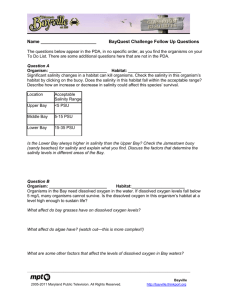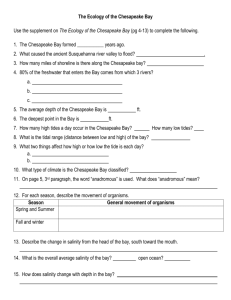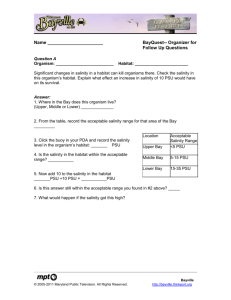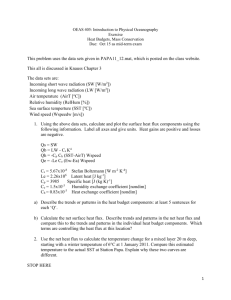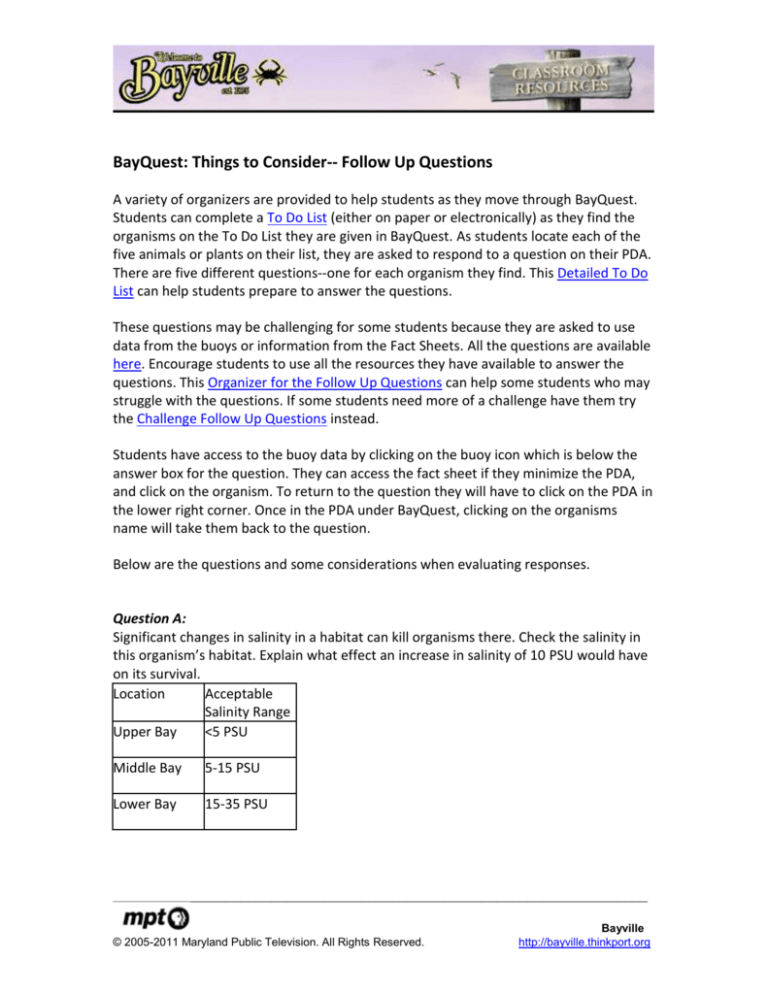
BayQuest: Things to Consider-- Follow Up Questions
A variety of organizers are provided to help students as they move through BayQuest.
Students can complete a To Do List (either on paper or electronically) as they find the
organisms on the To Do List they are given in BayQuest. As students locate each of the
five animals or plants on their list, they are asked to respond to a question on their PDA.
There are five different questions--one for each organism they find. This Detailed To Do
List can help students prepare to answer the questions.
These questions may be challenging for some students because they are asked to use
data from the buoys or information from the Fact Sheets. All the questions are available
here. Encourage students to use all the resources they have available to answer the
questions. This Organizer for the Follow Up Questions can help some students who may
struggle with the questions. If some students need more of a challenge have them try
the Challenge Follow Up Questions instead.
Students have access to the buoy data by clicking on the buoy icon which is below the
answer box for the question. They can access the fact sheet if they minimize the PDA,
and click on the organism. To return to the question they will have to click on the PDA in
the lower right corner. Once in the PDA under BayQuest, clicking on the organisms
name will take them back to the question.
Below are the questions and some considerations when evaluating responses.
Question A:
Significant changes in salinity in a habitat can kill organisms there. Check the salinity in
this organism’s habitat. Explain what effect an increase in salinity of 10 PSU would have
on its survival.
Location
Acceptable
Salinity Range
Upper Bay
<5 PSU
Middle Bay
5-15 PSU
Lower Bay
15-35 PSU
_______________________________________________________________________
© 2005-2011 Maryland Public Television. All Rights Reserved.
Bayville
http://bayville.thinkport.org
To Consider: Salinity tolerances vary widely among organisms in the Bay. For an
organism living in the upper part of the Bay where salinities are quite low an increase of
10 PSU would mean disaster. However, for an organism in the lower Bay, where higher
salinities are tolerated and more fluctuation is expected, an increase in 10 PSU could be
tolerable—depending on the current salinity level. In order to answer these questions
students will have to know where in the Bay they found this organism, and what the
current salinity is there. NOTE: The salinity at the Jamestown buoy is quite low, despite
Jamestown’s location in the Lower Bay. This is because the buoy is in a tributary that
flows into to the Bay, and not in the Bay itself. The few organisms found at the
Jamestown Sandy Beaches habitat can survive in a wide variety of salinities so as not
confuse users. Older students may find this something to investigate. More information
about salinity is available here . Additional information about salinity and physical
characteristics in general is available from the Chesapeake Bay program.
An animation of the changes in salinity of the Bay is available from VIMS (Virginia
Institute of Marine Science).
For Salinity maps of the Bay see the Maryland DNR (scroll down) and the Chesapeake
Bay Foundation.
A lesson on salinity is available here one of many bay backpack materials from the
Chesapeake Bay Program Education work group.
Question B:
Organisms in the Bay need dissolved oxygen in the water. If dissolved oxygen levels fall
below 5 mg/L many organisms cannot survive. Is the dissolved oxygen in this organism’s
habitat at a level high enough to sustain life?
To Consider: Dissolved oxygen (DO) levels are critically important to organisms in all
aquatic (water) environments. This question asks students to check the data in the Bay
and make sure that that habitat has enough dissolved oxygen to support life. (Note: the
buoys measure conditions at the surface of the Bay where DO levels are almost always
quite high. Problems usually occur in deeper waters; for an example of this check the
Gooses Reef data on the CBIBS site). Information about dissolved oxygen is available
here .
Find additional information about dissolved oxygen in the Bay from the Chesapeake Bay
Program and from Maryland DNR.
For maps and more about the current state of dissolved oxygen in the bay click check
the Eco-check report card.
Information on dead zones in other parts of the world is available from VIMS.
For more detailed information about dissolved oxygen look at Water on the Web.
_______________________________________________________________________
© 2005-2011 Maryland Public Television. All Rights Reserved.
Bayville
http://bayville.thinkport.org
Question C:
The growth of bay grasses and phytoplankton, primary producers in all Bay habitats, is
affected by turbidity. Check the salinity and turbidity levels in this organism’s habitat.
Use the table to determine if the turbidity is in the acceptable range. What are the
consequences if it is not?
Salinity Range Turbidity
Range
<5 PSU
< 17 NTU
5-15 PSU
< 6 NTU
15-35 PSU
< 3.5 NTU
To consider: In general, freshwater organisms can tolerate higher levels of turbidity
(more cloudy water) than can organisms that live in saltier waters. Bay water becomes
more turbid for two main reasons: sediment is washed into the Bay by erosion and
storm runoff, and/or algae have grown out of control. When water is cloudy,
underwater plants, such as bay grasses, do not get the light they need to grow properly,
and so other organisms that depend on these plants (pretty much everything) cannot
survive.
Students will have to check the salinity and turbidity levels at the buoy where the
organism is found in order to answer the question. They will have to assume that the
salinity level is within the suitable range for the organism they found there. More
information about turbidity is available here.
Find additional information on sediments and turbidity in the Bay from the Chesapeake
Bay Program, and general information on turbidity from Water on the Web.
Question D:
What does this organism eat? What organisms eat it? If this organism’s population
suddenly decreased, how would this affect the other organisms in the habitat?
To consider: This question addresses predator/prey and food web issues. Students will
have to refer back to the fact sheet for information on what the organism eats and is
eaten by. The students are also expected to understand that if the population of one
organism decreases the populations of the organism that eats it will likely decrease as
well. It is possible that the predators that consume the organism in question will switch
to a different food source—in which case that population will also be affected. A good
source of information on food chains and food webs in the Bay is from the Chesapeake
Bay Program.
The Bayville interactive Meal Deal addresses food chains and food webs in the Bay.
_______________________________________________________________________
© 2005-2011 Maryland Public Television. All Rights Reserved.
Bayville
http://bayville.thinkport.org
Question E:
Invasive species are organisms that are not native to a habitat and spread rapidly
because they have no predators and/or are not susceptible to the diseases that native
species are. Explain how an invasive species of fish might change this organism’s habitat.
To consider: An invasive species is defined as a species of organism that has been
introduced into an ecosystem, is living there, and having a negative effect on the
ecosystem. Invasive species are a serious issue in the Chesapeake Bay, threatening the
health of some native species. Students can approach this question in a number of ways
including predator/prey relationships or competition for food and/or habitat. Although
an invasive species is defined as having a negative effect on an ecosystem, the effect on
an individual organism may be positive, e.g. the organism can eat the invasive and its
population may grow. More information about invasive species in the Chesapeake Bay is
available from the Chesapeake Bay Program.
_______________________________________________________________________
© 2005-2011 Maryland Public Television. All Rights Reserved.
Bayville
http://bayville.thinkport.org

